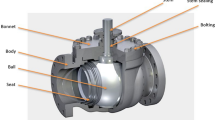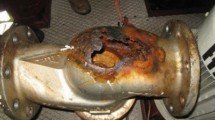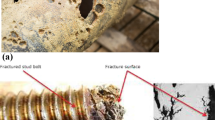Abstract
A valve is a mechanical component in a piping system that is used to open and close the fluid passage, avoid return of the fluid, control the flow, or for safety purposes. An industrial valve contains different parts in general, such as pressure-controlling and pressure-containing parts. The valve stem is categorized as a pressure-containing part, and failure of this component leads to leakage of the fluid to the environment. Thus, failure of the valve stem leads to asset losses, oil or gas spillage into the environment, human injury or death, and in general health, safety, and environmental concerns. Therefore, this article addresses some of the main stem design features to minimize the risk of failure in stem. The main design features are the maximum allowable stem torque to enable the stem to handle the operator torque or force, stem diameter calculation, material selection, anti-blow out and anti-static design. Different materials for the stem, especially those with high mechanical strength, are proposed in this article. The anti-blow out design feature and solutions for stem and closure member connection, as well as stem and body connection, have been explained in detail. The anti-static design will provide electrical continuity among the stem, ball, and body to minimize the risk of fire inside the valve due to the accumulation of static electricity in the valve’s soft materials, which has been explained. The valve stem sealing is not included in this article and requires separate research.


Courtesy: Springer



Similar content being viewed by others
References
B. Nesbitt, Handbook of Valves and Actuators: Valves Manual International, 1st edn. (Elsevier, Oxford, 2007)
P. Smit, R.W. Zappe, Valve Selection Handbook, 5th edn. (Elsevier, New York, 2004)
Trelleborg sealing solutions, Design Considerations for Subsea Valve Stem Seals (2017). https://www.knowledgecenter.trelleborg.com/article/design-considerations-for-subsea-valve-stem-seals/
K. Sotoodeh, Piping and valve materials for offshore use, part 1. Stainless Steel World Mag. 28(June), 40–44 (2016)
K. Sotoodeh, Piping and valve materials for offshore use, part 2. Stainl. Steel World Mag. 28, 35–40 (2016)
American Petroleum Institute (API), Specification for Pipeline and Piping Valves. API 6D, 24th edn. (API, Washington, DC, 2014)
International Organization for Standardization (ISO), Pipeline Transportation Systems: Pipeline Valves. ISO 14313, 2nd edn. (ISO, Geneva, 2007)
K. Sotoodeh, Pipeline valves technology, material selection, welding, and stress analysis (a case study of a 30” class 1500 pipeline ball valve). J. Press. Vessel Technol. Paper No. PVT-18-1043. American Society of Mechanical Engineers (ASME). https://doi.org/10.1115/1.4040139
International Organization for Standardization (ISO), Petroleum and Natural Gas Industries: Mechanical Integrity and Sizing of Actuators and Mounting Kits for Pipeline Valves (1st edn). ISO 12490: Geneva
American Petroleum Institute (API), Standard for Actuator Sizing and Mounting Kits for Pipeline Valves. API 6DX (1st edn). Washington, DC (2014)
K. Sotoodeh, Actuator Selection and Sizing for Valves. SN Appl Sci (2019). https://doi.org/10.1007/s42452-019-1248-z
K. Sotoodeh, The importance of maximum allowable stem torque in valves. SN Appl Sci 1, 433 (2019). https://doi.org/10.1007/s42452-019-0445-0
C. Gamero, How to properly size an actuator. MRC Global (2017). https://www.mrcglobal.com/Blog/Valve_Automation/Size-an-Actuator-D. Accessed 8 Dec 2019
G. Gokilakrishnan, S. Divya, R. Rajesh, and V. Selvakumar, Operating torque in ball valves: a review. Int. J. Technol. Res. Eng. 2(4) (2014). ISSN: 2347-4718. http://ijtre.com/images/scripts/2014020420.pdf. Accessed 8 Dec 2019
P.L. Skousen, Valve Handbook, 3rd edn. (McGraw-Hill Education, New York, 2011)
American Society of Mechanical Engineers (ASME), Valves-Flanged, Threaded, and Welding End. ASME B16.34, New York, NY (2004)
American Society of Mechanical Engineers (ASME), Pipe Flanges and Flanged Fittings: NPS ½ Through NPS 24 Metric/Inch Standard. ASME B16.5. New York, NY (2017)
FRAMES, Actuator Control System (2019). http://www.frames-group.com/Products/Actuator-Control-System. Accessed 24 Dec 2019
The Process Piping, Introduction to pressure safety valve (2019).https://www.theprocesspiping.com/introduction-pressure-safety-valve/. Accessed 24 Dec 2019
Y. Bai, Q. Bai, Subsea Engineering Handbook, 1st edn. (Elsevier, Atlanta, 2012)
K. Sotoodeh, A review on subsea process and valve technology. J. Mar. Syst. Ocean Technol. (2019). https://doi.org/10.1007/s40868-019-00061-4
American Society for Testing and Materials (ASTM), Standard Specification for Stainless Steel Bars and Shapes for Use in Boilers and Other Pressure Vessels. ASTM A479. Washington, DC
AK Steel, 17-4 PH Stainless Steel (2019). https://www.aksteel.com/sites/default/files/2018-01/174ph201706.pdf. Accessed 24 Dec 2019
National Association of Corrosion Engineers (NACE) MR0175-ISO15156, Petroleum and Natural Gas Industries-Materials for Use in H2S Containing Environments in Oil and Gas Production. Houston, TX (2015)
F. Fatechi, M. Innocenti, Chloride stress corrosion cracking of precipitation hardening SS impellers in centrifugal compressor. Laboratory investigations and corrective actions. J. Eng. Fail. Anal. 8(5), 477–492 (2001)
NORSOK, Material Selection. Norsok M-001 Rev 4. Lysaker, Norway (2004)
American Society for Testing and Materials (ASTM), Standard Specification for Forged or Alloyed Alloy Steel Pipe Flanges, Forged Fittings, and Valves and Parts for High Temperature Service. ASTM A182. Washington, DC
Special Metals, Inconel alloy 718 (2007). https://www.specialmetals.com/assets/smc/documents/inconel_alloy_718.pdf. Accessed 25 Dec 2019
American Society of Mechanical Engineers (ASME). Process Piping. ASME B31.3. ASME: New York, NY (2016)
Ball valve design features: a literature-part 3 of 4 (2019). https://www.whatispiping.com/ball-valve-design-features-literature-part-3. Accessed 26 Dec 2019
British Standard, Metal Ball Valves for Petroleum, Petrochemical and Allied Industries. BS EN ISO17292 (1st edn) (2004)
Acknowledgments
I would like to express my gratitute to my partner, Ms. Tamara Zhunussova for her constant support.
Author information
Authors and Affiliations
Corresponding author
Additional information
Publisher's Note
Springer Nature remains neutral with regard to jurisdictional claims in published maps and institutional affiliations.
Rights and permissions
About this article
Cite this article
Sotoodeh, K. Optimized Valve Stem Design in Oil and Gas Industry to Minimize Major Failures. J Fail. Anal. and Preven. 20, 634–640 (2020). https://doi.org/10.1007/s11668-020-00891-0
Received:
Published:
Issue Date:
DOI: https://doi.org/10.1007/s11668-020-00891-0




